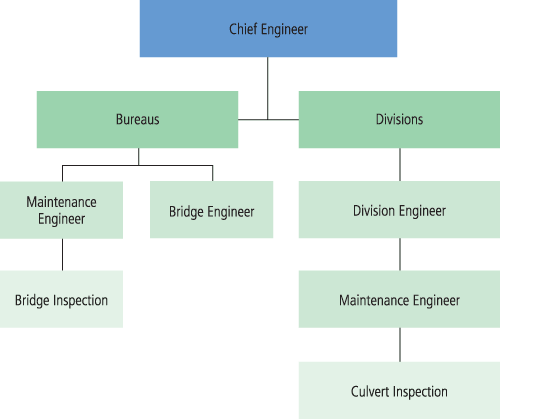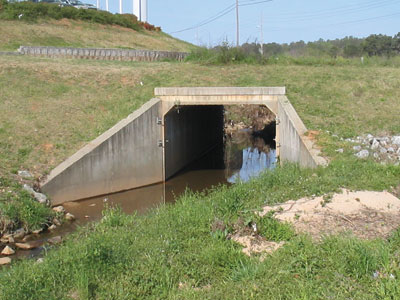Transportation Asset Management Case Studies
CMS Case Study
Alabama
In Alabama the responsibilities for inspection and management of State-owned culverts belong to the Alabama DOT (ALDOT). ALDOT has nine geographic divisions. Each encompasses several counties and has a headquarters office. Each division is responsible for managing highway and bridge construction contracts, as well as all maintenance functions, including pavement and bridge repairs. The divisions are further subdivided into districts with, typically, three to six districts within each division. ALDOT, headquartered in Montgomery, is responsible for more than 5,600 State-owned bridges.
Division of Responsibilities
The maintenance engineer in each of the ALDOT divisions is responsible for the inspections. Typically, these inspections are delegated to the districts. Figure 11 illustrates the ALDOT hierarchy.

Although culvert replacements and repairs can be part of a corridor improvement project, most are replaced individually. State forces primarily perform culvert maintenance and replace some minor drainage structures. ALDOT also handles culvert relining and filling with flowable fill, culvert extensions, and some invert paving. The majority of the work-more than 90 percent-is completed by contractors.
Culverts are typically installed at least 1 ft below the flow line to allow siltation to occur and to provide a "natural" bottom for fish passage and other aquatic species. ALDOT has recently created a section that handles water quality and environmental issues for all maintenance activities. Permits are required from the Alabama Department of Environmental Management (ADEMS), U.S. Army Corps of Engineers, U.S. Fish and Wildlife Service, and other environmental agencies.
Inventory and Inspection
All culverts and pipes ranging from 20 ft down to 15 in. are inventoried. The ALDOT Maintenance Bureau arranges this inventory of approximately 184,775 minor drainage structures by highway segment. Highway segments vary in length based on the type of roadway (i.e., rural or urban sections) or location (i.e., county or municipal sections). The count includes all of the minor drainage features along that roadway section and does not distinguish between different types or sizes of culverts. The vast majority of culverts in Alabama are made of steel or concrete. Some of the other structures are high-density polyethylene plastic.
Although ALDOT has not established a set frequency or cycle for inspections, the ALDOT Maintenance Manual recommends annual inspections if deemed necessary by the district engineer. After major rainfall or flooding, district roadway personnel conduct inspections by riding the highways and looking for any problems, such as ponding water, erosion, dips in the roadway, and other signs of distress. These inspections are for State-owned structures only and do not apply to local agencies.
The ALDOT employees who perform the culvert inspections are not required to have any formal bridge inspection training based on the NBIS. Inspections are not based on a formal rating or NBIS system, and formal inspection reports are not written. Since inspections are conducted as needed and do not adhere to a formal cycle, there is no database of inspection information or reports to share.
ALDOT uses a bridge inspection manual but not a separate culvert inspection manual. The field operations and maintenance manuals address but are not specifically geared toward culvert inspection. The inspections are conducted with flashlights, and on some occasions video equipment is used at the discretion of the district engineer. ALDOT is considering moving towards using video inspection for all of its small drainage structure inspections.
Prioritization
Instead of implementing a worst-first system for prioritizing culvert repairs and replacements, ALDOT fixes problems as they develop based on inspections.
Database
Instead of using the CMS software developed by FHWA, ALDOT has a computerized inventory system and a computerized maintenance management system. Developed in the 1970s, the maintenance management system can schedule future maintenance activities, but it cannot predict deterioration, estimate costs, or prioritize replacements. ALDOT has committed to changing and updating the system within the next few years and has expressed interest in a future version of the FHWA CMS software.
Funding
ALDOT has a dedicated budget for maintenance and inspection but does not have a dedicated budget for culvert replacements. The typical amount spent on culvert repairs and maintenance ranges from $1.5 to $2.5 million annually.
Conclusion

Although no failure of a small or minor drainage structure has occurred recently, ALDOT recognizes the importance of inventorying and inspecting these structures. The agency's program, however, is more reactive than proactive. ALDOT's interest in a future version of the FHWA CMS may lead the agency to develop a more formal system with official inspection guidelines and frequencies. With a formal CMS, the agency could manage its facilities more proactively and efficiently, possibly lowering the costs of the inspection, repair, and replacement process.
ALDOT welcomes Federal guidance for culvert inspection, but does not support a mandate because the agency is already conducting inspections on its own terms. Adhering to the notion that States should have the freedom to establish individualized standards, ALDOT prefers Federal guidance rather than Federal standards.
